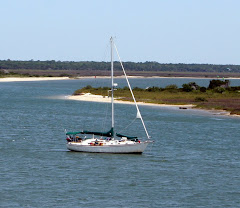
Introduction
We asked the kids to discuss what they learned on a really great nature hike we took earlier this week at the Exuma Cays Land & Sea Park... specifically, we asked them to share a story about a plant or animal they learned about and to comment on both the negative and positive impacts people have had on the fragile ecosystems that make up the Bahama Islands.
The kids have become very aware of their/our impact on the planet during our time cruising. Recently, a marina we stayed in offered 5 minute showers for $4.00. After about 3 minutes, Emily commented on the ridiculous waste of water! (We use about 10 gallons a week, in all.) She also carefully monitors the use of paper products on our boat to minimize trash.
Drew is a firm believer in the rule of only fishing for what you can eat... if you have fish on the boat; you should not be fishing for more. He also can’t stand to throw a used battery in the trash when it could be recycled.
As for Jake, he produces the least amount of laundry in the family (this is both a good and a bad thing!). He also makes sure we never leave the boat for a trip to a beach without a trash bag for picking up whatever might have washed ashore.
Here are their perspectives on the value of the Exumas Cays Land & Sea Park as a nature preserve, along with supporting photographs:
Magroves Ecosystem, by Emily
Mangrove is a water plant. It grows in a desurt/swamp area, and the yellow leaf sacrifisi itself (it takes the salt-water) then the other leaves have fresh water. Those are the green leaves.
The mangrove is very important. It nurchurs fish, birds, lobsters and crabs. All of those thigs live in the water except for the birds. They build there nests in the leaves of the mangroves.
The roots of mangroves stick up out of the ground like snorkels. The threats of mangroves are big, big marinas geting built. No wetlands = no fish, no coral reefs, NO GOOD!!!! Well, bye. Emily E.
Coral Reefs, by Jake
The coral reefs of the Bahamas are very beautiful. There made of little tiny microscopic animals called polyps. It will take fifty years for a polyp to build a pice of coral the size of a basket ball. The coral can get to any shape and size like horns, bowls, caves, brains, fans and flowers.
Coral reefs are important for marine life because they provide shelter. But they are in danger. Many are dying or cracking. One reason is greedy fisherman pouring bleach. 1 gallon can poison 500,000 gallons of sea water. Thing we can do. . . careful snorkeling, carful anchoring, no dumping trash, not fishing for more than you can eat. The End.
Protecting Lobster, by Drew
Baby lobsters grow in the sand after a week in the tides. When boats anchor in the (Exuma Land & Sea) Park they could kill 1,000 of baby lobsters. So the Park has put in moorings so it does not kill the lobster babies.
Of the 5.8 million lobsters caught each year, 5.4 million lobsters get exported to other countries and 400,000 go to locals and cruisers in the Bahamas. The Land and Sea Park is protecting the baby lobsters for the future, or there won’t be enough! Also, lobsters are important for coral reefs because they clean the reefs.
Besides protecting lobsters, the Park is also protecting the land. In the past, the Bahamas was a tropical rain forest. But when the British descovered all the wood, they cut it down for building ships. Now the Bahamas has no old growth trees at all. After all the lumber was taken from the island, some groups of Loyalists burnt the island so to start plantations of sugar cane. The plantations slowly went away after taking all the nutriets out of the soil.
The Land and Sea Park is now protecting the plants and trees that are here today. Now the land here looks like swiss chees but rock and like a desert. There are bushes and palmettos as well as mangroves. This is good because mangroves fields are like nurseries for lobsters, conch and more.





No comments:
Post a Comment